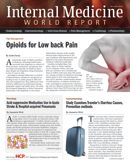Publication
Article
Internal Medicine World Report
Pneumonia is a Likely Risk Factor for Cardiovascular Disease
Author(s):
Cardiovascular disease is often preceded by pneumonia severe enough to be hospitalized for, according to research published in JAMA.

Pneumonia may be a risk factor for cardiovascular disease (CVD), suggested findings published in JAMA.
Researchers from the University of Pittsburgh examined cases of pneumonia to assess whether hospitalization for pneumonia is associated with an increased short- and long term risk of CVD. The patients were recruited from 2 centers followed up with over 21 years: the Cardiovascular Health Study ([CHS] 5,888 patients) and the Atherosclerosis Risk in Communities ([ARIC] 15,792 patients).
The CHS patients were enrolled at age 65 or older and aged 45-65 years in the ARIC study. Patients with CVD at hospitalization admission were excluded from the study, as the researchers were only interested in new incident CVD, including myocardial infarction, stroke, and fatal coronary heart disease.
The CHS cohort provided the researchers 591 pneumonia cases and 1,182 controls. Of the 591 patients with pneumonia, 211 cases were considered severe. The average pneumonia patient age was 73 years, the patients had a high burden of cardiovascular risk factors, and most were cognitively functional in the pre pneumonia period. Mortality after pneumonia was high. After 30 days, there were 111 deaths; at 90 days, 146 deaths; after 1 year, 212 deaths; after 5 years, 348 deaths; and after 10 years, 419 deaths. Corresponding morality in the control group was lower. After 30 days, 8 deaths occurred; at 90 days, 26 deaths; after 1 year, 92 deaths; at 5 years, 400 deaths; and at 10 years, 759 deaths.
CVD was higher in pneumonia patients than in controls, and the risk was highest during the first year. CVD was found in 54 cases of pneumonia and 6 controls after the first 30 days; 11 cases and 9 controls between 31-90 days; 22 cases and 55 controls between 91 days and 1 year. After the 1 year period, the risk of CVD was highest in the second year — when 28 cases and 53 controls developed CVD – but lowest in the seventh year – when 4 cases and 27 controls developed CVD.
The conclusion “provides yet another reason to do everything we can to prevent pneumonia from occurring in the community, through vaccination and basic hand hygiene, for example,” lead author Vicente Corrales-Medina, MD, MSc explained in a press release. “This is especially important for the elderly and those with other risk factors for cardiovascular disease, such as diabetes, smoking, and high cholesterol. Second, once pneumonia has occurred, physicians should develop a care plan understanding that these patients are more likely to develop cardiovascular disease in the weeks, months and years following their recovery from this infection. Such measures could include screening and primary prevention strategies for cardiovascular disease.”
The results of the ARIC study, which provided 13,810 eligible patients, were similar: pneumonia patients had a high burden of cardiovascular risk factors and mortality was high post pneumonia. After 30 days, there were 80 deaths; at 90 days, 107 deaths; at 1 year, 168 deaths; at 5 years, 300 deaths; and at 10 years, 518 deaths. The control patients had lower mortality rates: after 30 days, there were 4 deaths; at 90 days, 7 deaths; after 1 year, 24 deaths; after 5 years, 116 deaths; and after 10 years, 286 deaths. Again, the investigators noted similar trends in the risk for mortality post pneumonia: the highest risk was during the first year and through the second.
“Hospitalization for pneumonia is associated with increased short- and long term risk of CVD, suggesting that pneumonia may be an important risk factor for CVD,” the authors concluded.





